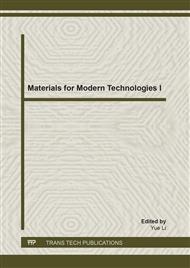[1]
Y.S. Kuo, A study of riser feeding behavior of high strength A201 aluminum alloy, Ph. D. Thesis, NCKU, Tainan, Taiwan, ROC (1990).
Google Scholar
[2]
E. Chang, Y.S. Kuo, Semi-Empirical analysis of thermal parameters for porosity formation in A201 aluminum alloy casting, AFS Trans. 102 (1994)167-172.
Google Scholar
[3]
A.L. Kearney, A.J. Raffin, Mechanical properties of aluminum castings alloy X206. 0-T4 and X206. 0-T7 vs comparable alloys at various cooling rates, AFS Trans. 85 (1977)559-570.
Google Scholar
[4]
S.T. McClain, J.T. Berry, B. Dawsey, A study of porosity and pore morphology in aluminum A356. 2 step castings, AFS Trans. 111 (2003)147-158.
Google Scholar
[5]
S. Poola, S. Felicelli, S. Leggett, J.T. Berry, A Re-examination of factors affecting porosity gradients in unidirectionally solidified samples, AFS Trans. 116 (2008)157-168.
Google Scholar
[6]
O.A. Atasoy, H.E. Exner, Effect of slow cooling rate on the microstructure of Sr-modified Al-Si eutectic alloys, Cast Metals. 1(1988)86-90.
DOI: 10.1080/09534962.1988.11818952
Google Scholar
[7]
Y.S. Kuo, Study of microstructure on the mechanical properties of A201 aluminum alloy castings, Foundry Technology (Zhuzao Jishu). 27(Nov. 2006)1196-1199.
Google Scholar
[8]
G.E. Nagel, J.P. Mouret, J. Dubruelh, A357 Type alloy with improved properties, AFS Trans. 91 (1983)157-160.
Google Scholar
[9]
G.K. MacAllister, Effect of cooling rates on the mechanical properties of A206. 0-T4 and A206. 0-T71 aluminum alloy castings, AFS Trans. 95(1987)775-786.
Google Scholar
[10]
A. Petro, R.A. Flinn, Mold-Metal interactions between chromite sand and cast steel, AFS Trans. 86 (1978) 357-364.
Google Scholar
[11]
J. Biel, K. Smaliuskas, A. Petro, R.A. Flinn, Variable affecting chromite sand performance in molds, AFS Trans. 88 (1980) 683-694.
Google Scholar
[12]
Y.S. Kuo, Effects of solidification time on porosity content in A201 aluminum alloy castings, Advanced Materials Research, 311-313 (2011)648-652.
DOI: 10.4028/www.scientific.net/amr.311-313.648
Google Scholar
[13]
U.D. Mallya, V. Panchanathen, Section feeding efficiency factor - a new parameter for soundness evaluation, AFS Trans. 82 (1974) 165-168.
Google Scholar


